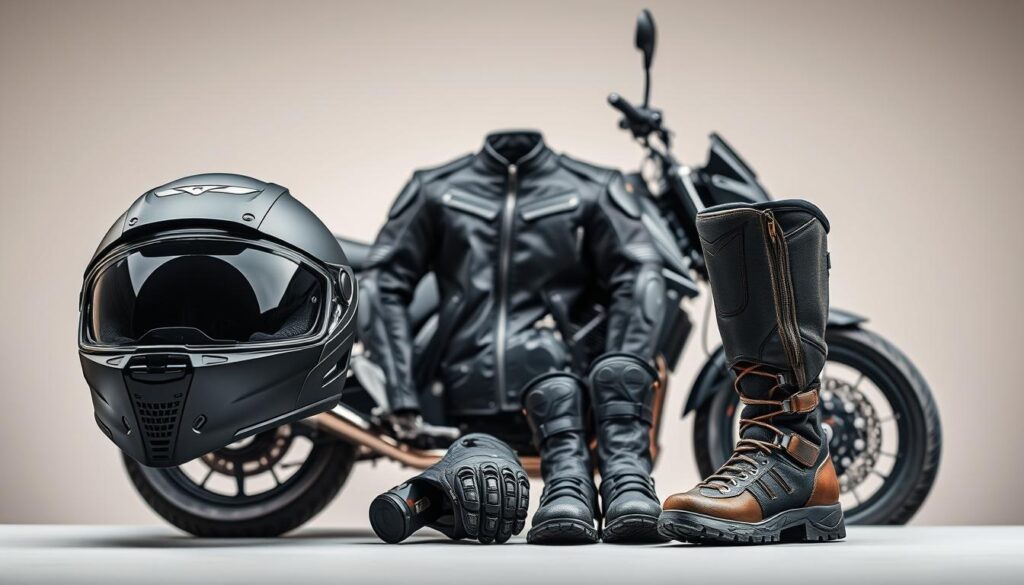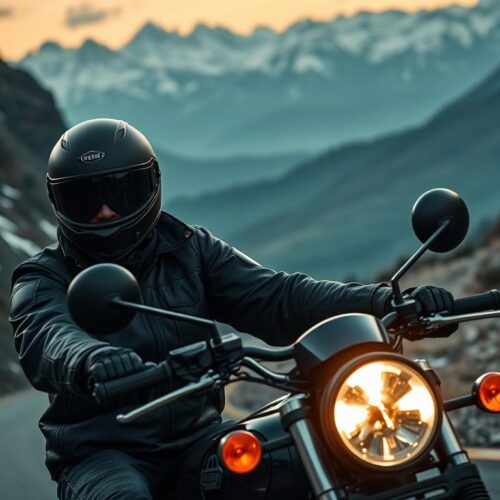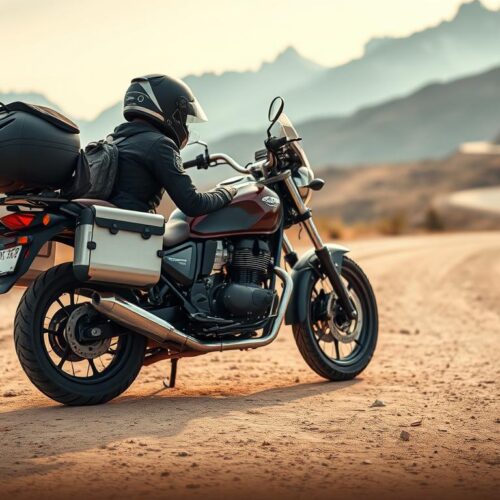Riding a motorcycle is thrilling when you’re out on the open road. But, staying safe should always come first. This guide will show you the key to motorcycle safety. You’ll learn how to ride safely and avoid dangers.
It focuses on defensive riding. This means you’ll learn how to handle various situations on the road. Using these tips can make you a better rider. And it will help you travel on your motorcycle responsibly.
Understanding Motorcycle Safety
Motorcycle safety is super important for anyone who rides. Unlike car drivers, bikers face more risks and need to be extra careful. Making safety a top priority can really lower the risk of having an accident or getting hurt. It’s important for riders to always ride safely and stay alert.
Road awareness is key when you’re on a motorcycle. You have to be super alert and ready to adjust how you’re riding based on what’s happening around you. Being able to spot dangers early can help you avoid sudden stops or quick turns. Knowing how to brake properly and keeping a safe distance from other vehicles gives you more time to deal with surprises.
Having the right posture when you ride is also crucial. You should sit up straight, keep your elbows bent a bit, and your feet should be firmly on the foot pegs. This position helps you stay comfy and control your bike better, especially when you need to dodge something on the road.
Using defensive riding techniques is a big part of staying safe. The more you practice recognizing dangers, the better you’ll get at avoiding them. Keep learning and improving your riding skills. For great tips on getting better at riding and staying safe, check out this link.
Choosing the Right Motorcycle
Selecting the right motorcycle ensures safe riding and a superb experience. Different types suit various riding styles and skill levels. It’s key to understand these to find the best bike for you.
Here are some common motorcycle types:
- Cruisers: These have a low seat and are comfortable, great for beginners.
- Sport Bikes: These are fast and agile, good for those with experience who want performance.
- Touring Bikes: Made for long rides, they offer comfort features like big windscreens and storage.
- Dual-Purpose Bikes: Good for on-road and off-road, perfect for adventurers.
To choose the right bike, think about:
- Seat Height: You should easily touch the ground with both feet.
- Weight: Beginners find lighter motorcycles easier to control.
- Power: Know the engine’s size and power to match your experience.
Checking a used motorcycle well is key for safety. Look for any damage or wear and tear. Regular maintenance boosts performance and safety on the road.
Essential Safety Gear for Riders
Choosing the correct safety gear is key to motorcycle safety. Strong personal protective equipment (PPE) really matters, no matter the helmet laws in your area. A helmet approved by DOT is your main protection for the head. It must fit right, feeling snug and comfy. It’s crucial for protecting you when things go wrong.
Your clothing is also a big part of keeping safe. Jackets and pants that resist abrasion from leather or synthetic stuff keep you safe from road burns. Gloves boost your hold on handles and keep your hands safe if you fall. Shoes that are tough protect your feet and ankles.
Being seen is super important for safety on a bike. Choosing gear that’s bright or has reflective bits makes others see you better, day or night. This can really help avoid accidents, especially when it’s dark.
| Gear Type | Features | Benefits |
|---|---|---|
| DOT-Approved Helmet | Impact-resistant, comfortable fit | Reduces head injury risk |
| Protective Jacket and Pants | Durable, abrasion-resistant | Offers protection against road rash |
| Gloves | Grip-enhancing, protective materials | Protects hands in falls, improves control |
| Footwear | Sturdy, ankle-supportive | Safeguards feet and ankles from injuries |
| Visibility Gear | Bright colors, reflective elements | Enhances visibility to other drivers |

Performing Pre-Ride Checks
Before you head out, it’s smart to check your motorcycle’s condition. Doing these checks can stop small problems from becoming big ones. The T-CLOCS method makes sure you inspect everything carefully, so you can ride safely.
- Tires and Wheels: Check tire pressure, tread depth, and overall wheel condition.
- Controls: Ensure that all levers, throttle, and brake systems function smoothly.
- Lights and Electrics: Test headlights, taillights, and turn signals for proper operation.
- Oils and Other Fluids: Verify oil levels and fluid leaks, including coolant and brake fluid.
- Chain and Drive Train: Inspect the chain for proper tension and lubrication.
- Stand: Confirm that the kickstand and center stand function properly.
By doing these steps, you make your ride safer. Paying attention here prevents problems, letting you fully enjoy your trip.
| Pre-Ride Check | Importance | Common Issues to Look For |
|---|---|---|
| Tires and Wheels | Prevent blowouts and ensure handling | Low pressure, worn tread |
| Controls | Avoid accidents, maintain maneuverability | Stiff levers, unresponsive throttle |
| Lights and Electrics | Ensure visibility and communication | Burnt bulbs, faulty wiring |
| Oils and Other Fluids | Maintain engine performance | Low oil, fluid leaks |
| Chain and Drive Train | Ensure smooth operation | Loose chain, lack of lubrication |
| Stand | Safety when parked | Wobbly stand, incomplete retraction |
Riding Techniques for Safety
Learning the right riding techniques greatly improves motorcycle safety. Choosing the right speed is key on different roads. By adjusting how you use the throttle and brakes, you keep your ride smooth. Knowing how to handle turns is also critical. Leaning into turns and shifting your weight improves your bike’s stability.
Riding safely in all kinds of weather is a must. In rain, go slower and leave more space ahead. In snow or ice, be very careful with how you use the brake and throttle to avoid sliding. Knowing how to ride on city streets and country roads is also helpful.
Here are some tips to make your motorcycle rides safer:
- Keep enough space between you and the vehicle in front to react safely.
- Position yourself well in lanes to be seen easily and avoid blind spots.
- Stay relaxed but ready to react, which helps in controlling the bike better.
How you position your body during turns and bends is key to handling your bike well. Keep your upper body relaxed but use your legs to hold onto the bike tightly. This makes the ride smoother and easier to control.
| Riding Conditions | Recommended Techniques | Safety Tips |
|---|---|---|
| Rain | Reduce speed, avoid sudden moves | Increase space ahead, use the throttle gently |
| Snow/Ice | Be gentle with throttle and brakes | Don’t make sudden moves, look for good grip places |
| Urban | Watch out for obstacles and people walking | Check mirrors often, signal before turning |
| Rural | Be alert for animals and varying road surfaces | Watch for slippery gravel, stay focused while riding |
Defensive Riding Strategies
Defensive riding boosts your safety on a motorcycle. It means being proactive about how you ride. One key part is always being aware of the road around you. By checking for dangers like potholes or sudden moves from cars, you stay safe.
Keeping a safe distance from other vehicles is vital. It gives you time to react and lowers crash risks. Use body signals and smart lane use to talk to other drivers.

Being seen is key to safety. Wear bright clothes and keep your lights on in daylight. Also, guess what other drivers might do. This way, you can ride safer and avoid accidents.
Using these defensive strategies makes each ride safer. Every trip has its own risks, so stay alert and flexible.
Navigating Challenging Weather
Weather can greatly impact your safety on a ride. Riding in rain demands you change how you ride. Slowing down is key for better control on slippery roads. It also helps to increase your distance from the next vehicle, giving you more time to react to sudden events or hazards due to bad weather.
In fog or heavy rain, seeing and being seen gets hard, so turning on your motorcycle’s headlights is a must. If you feel your bike start to slide or lose grip, that might be hydroplaning. To avoid making this worse, don’t suddenly speed up or make sharp turns.
| Weather Conditions | Safe Riding Tips |
|---|---|
| Rain | Reduce speed, increase following distance, and use smooth inputs on controls. |
| Fog | Use low beam headlights, maintain a slower pace, and be cautious of sudden stops. |
| Wind | Hold the handlebars firmly, lean into the wind, and be ready for gusts. |
| Cold | Wear appropriate gear to stay warm, and allow for longer stopping distances as brakes may be less effective. |
Getting ready for different weather conditions makes your ride better and more comfy. By keeping these tips in mind, you can handle tough situations better. This means you’ll have a safer trip every time you ride.
Understanding Road Hazards
Knowing about road hazards is key to motorcycle safety. Things like potholes, debris, uneven roads, and animals are big risks. If you spot these early, your ride can be safer and more enjoyable. Being aware helps you deal with surprises on the road.
To get better at noticing hazards, try the SEE strategy. It stands for Search, Evaluate, and Execute. This method helps you look for dangers, think about their effects, and act right. This way, you can ride more confidently and carefully.
Be aware of these common road dangers:
- Potholes
- Loose gravel
- Wet or icy surfaces
- Animals crossing the road
- Road construction and debris
Being more alert to these dangers lets you avoid risks and stay safe. Keeping an eye out makes your rides smoother. This lets you relish the freedom of biking while keeping safety first.
Joining the Motorcycle Community
Joining the motorcycle community can make your riding more fun. You get to feel like you’re part of a team. You meet others who love motorcycles as much as you do. By joining local riding groups, you become part of a group that cares about riding safely and learning new things. These groups often have events and workshops, which are perfect for sharing stories and getting new tips.
Going on group rides is really helpful too. They let you pick up tips from riders who have been doing this for a long time. When you ride together, these experienced motorcyclists can teach you how to stay safe on the road. The wisdom in the community can help everyone be safer, making sure that everyone rides with care and knows what to do.
Being in the motorcycle community not just improves your skills but also shows you the value of riding safely. You get chances for mentoring and working together, creating a place where riders support each other. No matter if you’re new to this or have been riding for years, joining local groups can help you enjoy your motorcycle journey even more.




